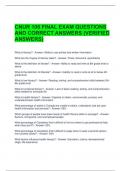Exam (elaborations)
CNUR 106 FINAL EXAM QUESTIONS AND CORRECT ANSWERS (VERIFIED ANSWERS)
- Course
- Institution
CNUR 106 FINAL EXAM QUESTIONS AND CORRECT ANSWERS (VERIFIED ANSWERS) What is literacy? - Answer- Ability to use printed and written information What are the 3 types of literacy tasks? - Answer- Prose, document, quantitative What is the definition of literate? - Answer- Ability to read and wr...
[Show more]



